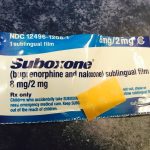10 Signs Suboxone Dose Is Too Low

Suboxone is a medication commonly used in the treatment of opioid dependence. It contains two active ingredients: buprenorphine and naloxone. Buprenorphine is a partial opioid agonist that helps reduce withdrawal symptoms and cravings, while naloxone is an opioid antagonist that helps deter misuse of the medication.
The dosing of Suboxone depends on various factors, including the severity of opioid dependence, previous treatment history, and individual response to the medication. It is essential to consult with a healthcare professional, such as a doctor or addiction specialist, for personalized dosing recommendations. However, I can provide you with some general information.
Suboxone is typically initiated once a person is experiencing mild to moderate withdrawal symptoms. The initial dose is usually administered when the individual is in the early stages of withdrawal, typically within 6-12 hours after the last opioid use. The standard starting dose is 2-4 mg of buprenorphine combined with 0.5-1 mg of naloxone.
After the initial dose, the healthcare provider will assess the individual’s response and adjust the dosage accordingly. The goal is to find the lowest effective dose that suppresses withdrawal symptoms and reduces cravings without causing significant side effects.
For most individuals, the maintenance dose of Suboxone ranges between 8-16 mg of buprenorphine and 2-4 mg of naloxone per day. The medication is usually taken once daily, either as a sublingual film or tablet that dissolves under the tongue. It’s important to follow the specific instructions provided by the healthcare professional or the medication’s label.
The duration of Suboxone treatment varies depending on individual needs and progress. It can range from several months to years, with a gradual tapering of the dosage under medical supervision when the individual is ready to discontinue the medication. This article aims to provide a comprehensive understanding of the signs that indicate a Suboxone dose may be too low, emphasizing the importance of proper dosing in opioid dependence treatment.
Signs Suboxone Dose Is Too Low
Inadequate dosing can lead to various challenges, including persistent cravings, withdrawal symptoms, and difficulties in maintaining long-term recovery. Here are the signs Suboxone dose may be too low:
1. Continued Cravings: One of the primary goals of Suboxone treatment is to alleviate cravings for opioids. However, if an individual consistently experiences intense cravings despite being on Suboxone, it could be an indication that the current dose is insufficient. Cravings can be a powerful trigger for relapse, highlighting the need for an adequate dosage to effectively suppress them.
2. Withdrawal Symptoms: Suboxone is specifically designed to ease withdrawal symptoms associated with opioid cessation. If an individual on Suboxone starts experiencing symptoms such as sweating, nausea, muscle aches, anxiety, or insomnia, it may suggest that the dose is too low. These symptoms can be uncomfortable and demotivating, hindering the recovery process.
3. Increased Opioid Use: A significant red flag that the Suboxone dose is inadequate is an increase in opioid use or attempts to self-medicate with additional opioids. If an individual finds themselves needing to supplement their Suboxone treatment with opioids, it suggests that the current dose is not providing sufficient relief, leaving them vulnerable to continued opioid use.
4. Mood Swings and Irritability: Inadequate Suboxone dosing can contribute to mood swings, irritability, and emotional instability. Buprenorphine, the active ingredient in Suboxone, helps stabilize mood by occupying opioid receptors in the brain. When the dose is too low, this stabilization may not be achieved, leading to mood disturbances that can impact daily functioning and overall well-being.
5. Physical Discomfort: Insufficient Suboxone dosing can result in ongoing physical discomfort. Individuals may experience persistent body aches, restlessness, gastrointestinal upset, or a general sense of malaise. These physical symptoms can be distressing and make it challenging to engage in daily activities or focus on recovery-related tasks.
6. Difficulty Focusing: Suboxone treatment aims to provide stability and improve cognitive functioning. However, if an individual on Suboxone finds it difficult to concentrate or experiences frequent lapses in attention, it may indicate that their dose is too low. Inadequate dosing can impede cognitive processes, making it harder to stay engaged in therapy and other essential aspects of recovery.
7. Frequent Relapses: Persistent relapses despite being on Suboxone may be a clear sign that the current dose is not adequately supporting recovery efforts. When the dose is too low, it fails to provide the necessary relief from cravings and withdrawal symptoms, leaving individuals vulnerable to relapse. Proper dosing is essential for reducing the risk of relapse and maintaining long-term sobriety.
8. Cravings for Higher Doses: If an individual consistently experiences cravings for higher doses of Suboxone or feels dissatisfied with the effects of their current dose, it could be an indication that the dose is too low. It is crucial to communicate these concerns with healthcare professionals, who can assess the situation and make appropriate adjustments to ensure optimal treatment outcomes.
9. Poor Response to Therapy: Suboxone is often used as part of a comprehensive treatment approach that includes counseling and therapy. However, if an individual is not experiencing significant progress in therapy or struggling to actively engage in treatment, it may be a signal that their Suboxone dose is inadequate. Therapy plays a vital role in addressing the underlying causes of addiction and developing coping mechanisms. When the Suboxone dose is too low, it may impede the individual’s ability to fully participate in therapy, hindering their overall progress.
10. Persistent Opioid Dependence Symptoms: If an individual continues to exhibit symptoms associated with opioid dependence despite being on Suboxone, it suggests that their current dose is not effectively managing their condition. Opioid-seeking behaviors, preoccupation with using opioids, and an inability to function without opioids are all indications that the dose may need adjustment. It is crucial to address these symptoms to prevent relapse and support the individual’s journey toward recovery.
What To Do If You Experience Signs Of Low Suboxone Dose
If you experience signs that indicate your Suboxone dose may be too low, it is important to take action to address the issue. Here are some steps you can take:
1. Communicate with your healthcare provider: Reach out to your prescribing doctor or addiction specialist and inform them about the signs you are experiencing. They are best equipped to evaluate your situation, assess your symptoms, and determine if a dosage adjustment is necessary.
2. Be open and honest: During your discussion with your healthcare provider, be open and honest about your symptoms, cravings, and any difficulties you are facing. Providing accurate and detailed information will help them make an informed decision about adjusting their Suboxone dose.
3. Follow professional advice: Your healthcare provider may recommend specific steps based on your individual circumstances. This could include adjusting the dosage, altering the dosing schedule, or considering additional treatment options. It is crucial to follow their guidance and adhere to their recommendations.
4. Attend regular appointments: Continue attending scheduled appointments with your healthcare provider for follow-up assessments. These appointments allow them to monitor your progress, evaluate the effectiveness of the dosage adjustment, and make any necessary further changes to your treatment plan.
5. Engage in counseling and support: Alongside medication, counseling and support play a vital role in addiction recovery. Ensure that you are actively participating in therapy sessions, counseling, or support groups. These resources can provide additional tools, coping strategies, and emotional support to complement the medication-assisted treatment.
6. Seek additional support: If you continue to experience signs of low Suboxone dose despite dosage adjustments, it may be beneficial to seek a second opinion or consult with an addiction specialist. They can provide a fresh perspective, evaluate your treatment plan, and offer alternative strategies to manage your symptoms effectively.
7. Practice self-care: Taking care of yourself is essential during the recovery process. Engage in activities that promote your overall well-being, such as regular exercise, maintaining a healthy diet, practicing mindfulness or meditation, and getting sufficient sleep. These self-care practices can support your recovery journey and help manage symptoms effectively.
8. Avoid self-medication or dose adjustments: It is crucial to avoid making any changes to your Suboxone dose or self-medicate with additional opioids. Any adjustments to your medication should be done under the guidance of a healthcare professional. Self-medication can lead to complications, setbacks in recovery, and potentially dangerous situations.
Remember, each person’s journey to recovery is unique, and finding the right Suboxone dose requires individualized attention and monitoring. By effectively communicating with your healthcare provider, seeking appropriate support, and adhering to professional advice, you can address signs of a low Suboxone dose and optimize your treatment outcomes.
Conclusion
Recognizing the signs that a Suboxone dose may be too low is essential for optimizing treatment outcomes in individuals with opioid dependence. From persistent cravings and withdrawal symptoms to increased opioid use and poor response to therapy, these signs indicate the need for dosage adjustment. Proper dosing is crucial for suppressing cravings, alleviating withdrawal symptoms, and supporting long-term recovery. If you or someone you know is experiencing any of these signs, it is important to consult with a healthcare professional, such as a doctor or addiction specialist, who can evaluate the situation and make the necessary adjustments to the Suboxone dose. By addressing the issue of inadequate dosing, individuals can enhance their chances of successful recovery and regain control of their lives.





